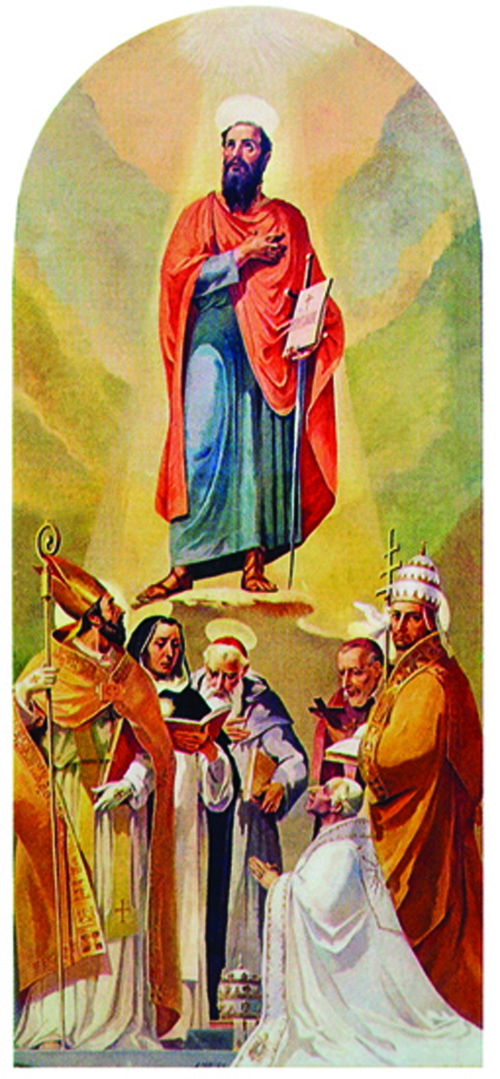Armanda Santos, FSP, 21/11/2016
Our hope is that as your faith increases the scope of our activity will be greatly enlarged, so that we’ll be able to proclaim the good news to lands beyond you....
2 Corinthians 10:15–16
The Italian artist Aronne del Vecchio painted this fresco of St. Paul in 1961 at the request of Blessed James Alberione, founder of the Daughters of St. Paul and the other religious institutes that make up the Pauline Family. The city of Rome was celebrating the centenary anniversary of the Apostle’s arrival there. To mark the occasion, Alberione commissioned two altars for the Queen of Apostles Basilica, the church he had built after World War II in honor of the Madonna. One altar was to feature a painting of Jesus, the Divine Master or Teacher; the other, his faithful disciple, Paul. Blessed Alberione expressed the desire that the painting of Jesus appear directly across from that of Paul, indicating that Jesus was the sole inspiration and model for the Apostle’s life and teaching.
For Alberione, Paul was the most faithful guide in the following of Jesus. The painting, which depicts St. Paul in glory, visually represents the centrality of the Apostle Paul in the life of the Church. Paul holds a place of prominence in the fresco, identifying him as a point of reference for how we as Christians are to know and live Jesus Christ and communicate him to the world. The marble archway encasing the fresco conveys the image of a large doorway, through which the viewer not only glimpses Paul’s glory but also is invited to enter and be counted among the Apostle’s devotees.
The fresco is divided into two parts. In the upper portion, Paul wears a red mantle over a green tunic. While the color red is usually associated with martyrdom, power, and love, green is often used to represent hope, victory over death, and newness of life. These colors consistently figure into the extensive iconography of Paul.
At his left side Paul holds a book and sword, symbols of his mission and martyrdom, which witness to his radical response to the following of Jesus. Here the closed book seems to suggest the “mystery to be revealed” (cf. Col 1:26) and announced to all people. Paul thus becomes the exemplar for those called to know, live, and announce the mystery of Christ.
Paul’s sandals are planted firmly on the ground; these recall his journeys made to preach the Gospel, extending to lands where no one had yet arrived to announce the Good News of Jesus Christ. The Apostle’s upright stance symbolizes his availability and readiness for service, while the hand placed over his heart suggests that what Paul transmits is the ardor of his love for Christ and his Church. The image reminds us that all Christians, called by baptism to share the spiritual richness they have received with others, are heirs of this great love.
In the fresco Paul stands against, above, and in front of layers of clouds, varying in gradation from dark to light until reaching the point of ultimate brightness. A radiant light streaming from the heavens floods Paul, whose eyes are raised in a gaze of contemplation. He seems
to be communicating to his devotees that their point of reference is not himself but Jesus Master, the crucified and risen Lord who chose Paul to be a “vessel of election” to the nations. The light cascades downward in a triangular shape, symbolizing the presence of the Trinity and recalling the moment of his encounter with the Divine as described in the Acts of the Apostles: “I saw a light more brilliant than the sun shining around me and those who were traveling with me” (Acts 26:13).
In the lower part of the fresco, we see that the light envelops not only Paul but also the group of men standing at his feet. These are various Doctors of the Church who drew inspiration from the great Apostle to the Gentiles. Paul was their teacher, the one who embodied for them in a particular way the doctrine of Jesus Christ and from whom they reaped the insight and knowledge they then shared with others. Blessed Alberione considered these saintly theologians particularly significant. They were successful in confronting the erroneous teachings of their times and in helping to form in their contemporaries a Christian mentality that realized “the embrace among the two sisters, science and faith.”
The figures are, from left to right:
St. Augustine: bishop, theologian, and Doctor of the Church. Under his left arm Augustine clasps a closed book, and in his right hand he holds the pastoral staff of a bishop.
St. Thomas Aquinas: theologian and Doctor of the Church. Thomas, nicknamed the “Angelic Doctor,” peers intently into an open book. He wears the white and black habit of the Dominicans.
St. Bonaventure: bishop, theologian, and Doctor of the Church. The saint’s eyes are lowered and his hand rests upon his heart. These are gestures indicating the humility of the “little brothers” of the Order of Friars Minor. Bonaventure, a Franciscan, is depicted in this fresco with the red biretta of his episcopal office as cardinal.
St. Alphonsus de Liguori: bishop, theologian, and Doctor of the Church. Alphonsus contemplates the crucifix, a reference to the Redemptorists, the religious order he founded.
St. Gregory the Great: pope and Doctor of the Church. Gregory’s gaze is turned toward the viewer. He too holds a book and his pastoral staff. His office as supreme pontiff is indicated by the tiara, or triple crown, which, along with the dove whispering in his ear, is Gregory’s traditional attribute.
Pope Leo XIII: the only one on his knees, possibly because he is the only figure in the painting not canonized. Leo’s hands are joined in prayer, and his tiara rests beside him on the ground. This pope was highly significant to Blessed Alberione’s mission.
These Doctors of the Church, taken as a whole, represent the Church— teacher and communicator— in its mission of presenting to the world the truth (i.e., religious teaching or doctrinal content), the life (of sacramental grace), and the way (or moral code) of Jesus Christ. The fresco also shows that a number of the saints, in addition to being portrayed with their traditional attributes, also carry a book representing their contribution to a particular area of expertise: St. Augustine, systematic theology; St. Thomas Aquinas, philosophy; St. Bonaventure, mystical theology; St. Alphonsus de Liguori, moral theology; and St. Gregory the Great, liturgical theology.
The inclusion of Pope Leo XIII is especially important for Blessed Alberione. This great pope wrote the encyclical Tametsi Futura Prospicientibus (On Jesus Christ Our Redeemer), which he promulgated on November 1, 1900. The document gave spiritual and apostolic direction to the then-sixteen-year-old seminarian James Alberione, preparing him for the mission of communicating Jesus Master, Way, Truth, and Life to the world in the manner of the great Apostle Paul. After ordination and throughout his life, Alberione’s goal was to make the word of God known and proclaimed to his contemporaries, especially by using the modern media to reach a wider audience. But Alberione was not content to work alone in spreading God’s word; through divine inspiration, and with the Church’s approval, Alberione went on to found five religious congregations, four secular institutes, and a group of cooperators— ten religious groups in all. This hugenarmy of consecrated and lay men and women who became known as the Pauline Family has a particularly close relationship with St. Paul because Alberione had a great admiration for this saint.
Alberione considered St. Paul the saint of universality not only because, with Peter, he was a founding pillar of the Church, but also because Paul’s message is for everyone. The priest’s admiration of and devotion to Paul began through reading, study, and meditation on the Letter to the Romans. Writing in his memoirs, Alberione explains that “from then on, Paul’s personality, his holiness, his heart, his intimacy with Jesus, his contribution to dogmatic and moral teaching, his impact on Church organization, and his zeal for all peoples— all became topics for meditation. Paul came across as the Apostle, and thus every apostle and every apostolate could draw from him.”
In the slab of marble under the fresco is inscribed in Latin: “St. Paul Apostle, Vessel of Election, Teacher of the Gentiles, Martyr and Protector of the Editions.” These titles are more than engraved words on a wall. Alberione’s idea was to have his followers consider Paul, and not himself, as the true founder of the Pauline Family. Each of them was to aspire to be Paul living today through the “Apostolate of the Editions,” a phrase that refers to the particular apostolic work of the Pauline Family, which has the mission to evangelize from within our media culture and, using the media themselves, to proclaim to the world Jesus Christ as Lord.
About the image:
Aronne del Vecchio. St. Paul the Apostle (1961). Basilica Minore Santa Maria Regina degli Apostoli, Rome, Italy. Photo: Mary Emmanuel Alves, FSP.
Armanda Santos, FSP, is a Daughter of St Paul and Director of Field Education for St Patrick's Seminary, Menlo Park, California.













